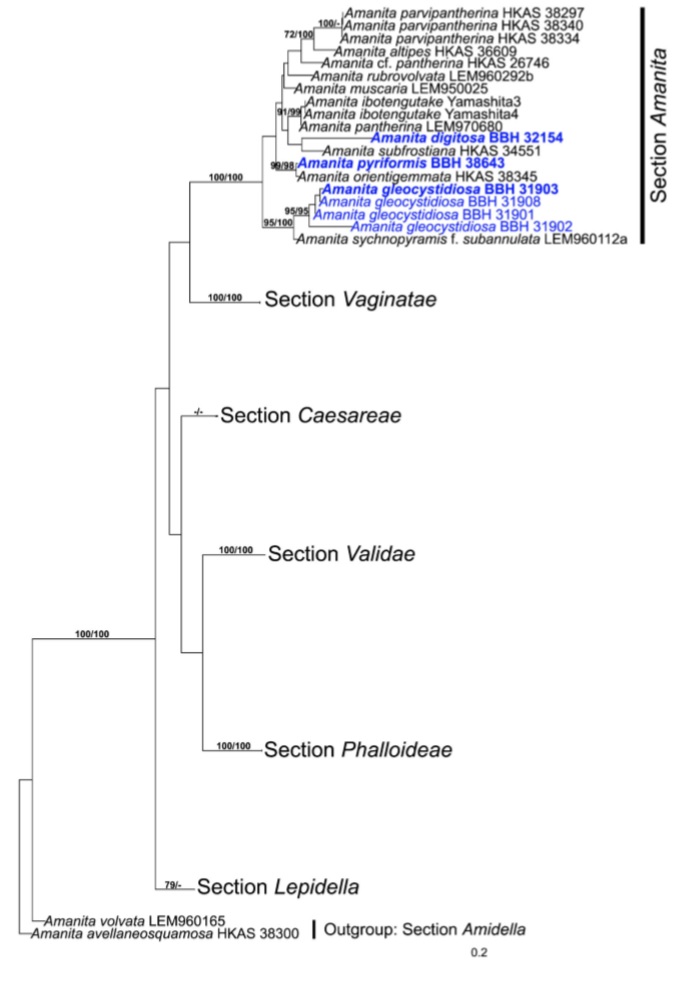Amanita pyriformis Boonprat. & Parnmen
Index Fungorumnumber: IF551620 Faceoffunginumber: FoF 02072
Etymology: The specific epithet refers to a type of pleurocystidia ‘pyriformis’=pear-shaped, narrowly obovoid with a tapering base.
Holotype: BBH 38643. Pileus 33–55 mm, convex when young, plane with age, rugulose, umbonate, the whole pileus grayish yellow 1(B)3– 7 and yellowish orange 4(A–B)7–8 at margin, dry, striate 1/8 from margin toward to disc, margin even. Pileus context off white,soft. Lamellae free, unequal, subdistant, broad,eroded, grayish yellow 1(B)3–7. Stipe 79–112×3–7.5 mm, central, cylindrical, enlarged base, grayish yellow 1(B)3–7 with yellowish orange 4(A–B)7–8 at stipe base near volva, soft. Annulus cream, hanging about 1/3 of pileus from stipe apex, single, sheathing, smooth, white, thin, apical attachment 19– 27 mm from base toward the apex. Volva constricted, adherent with flaring margin, white. Basidiospores (7–)8 –10×(6–)7 –9 μm [x=9.12 ±0.97×7.76±0.83μm, Q=1.18±0.14, n=25 spores, 1 collection] broadly ellipsoid, smooth, hyaline, inamyloid, thin walled. Basidia 29.5×11.5μm, clavate with 4-spores, clamp connection absent, smooth, hyaline, inamyloid, thin-walled. Basidioles 16–26×6.5–11μm, clavate to broadly clavate, sometimes pyriform,smooth, hyaline, inamyloid,thin-walled. Pleurocystidia 28–30×7–8μm, clavate to pyriform, smooth, hyaline, inamyloid, thin-walled. Cheilocystidia absent. Lamellae trama divergent, composed with broadly clavate to broadly ellipsoid cells, smooth, hyaline, dextrinoid, thin walled, base of hymenial layers directly arising from a few layer of cellular cells which connects to trama element. Pileipellis composed with cutis of repent hyphae, cylindrical, smooth, hyaline, inamyloid, thin-walled. Stipilipellis composed with cutis of 3.5–7.5μm diam. of repent hyphae, sometime obclavate cells, found among simple cylindrical cells, smooth, hyaline, inamyloid, thin-walled. Stipe trama composed of two types of element: repent hyphae and broadly clavate to broadly ellipsoid, smooth, hyaline, inamyloid, thin-walled. Volva composed of three types of element: 2– 6.8μm diam. of repent hyphae, broadly clavate to broadly ellipsoid cells 32–52×11.5–26μm and branching of repent hyphae, smooth, hyaline, inamyloid, thin-walled. Clamp absent in all parts of basidiomata.
Habitat: Terrestrial in mixed forest.
Material examined: THAILAND, Chiang Mai Province, Omkoi District, Mae Tun Tumbon, 27 June, 2014, collector SRRTTeam, Bureau of Epidemiology, Department of Disease Control Ministry of Public Health (BBH38643, holotype)
Notes: Amanita pyriformis is similar to A. orientigemmata Zhu L. Yang & Yoshim. Doi (Yang and Doi 1999) in having broadly ellipsoid basidiospores, but differs from A. orientigemmata in having smaller, umbonate, pale yellow basidiomata and presence of pleurocystidia, while A. orientigemmata has larger basidiomes, up to 100 mm wide, floccose patches on the pileus and the absence of pleurocystidia. ITS sequence data belonging to core taxa of different sections of Amanita were selected based on current classification and phylogeny of the genus Amanita (Zhang et al. 2004). A matrix of 1,005 unambiguously aligned nucleotide characters was constructed and 276 characters were constant. The topology of the trees from the maximumlikelihood (ML) and maximumparsimony (MP) analyses did not show any conflict and hence, only the ML tree.The boundary of each section is supported as monophyletic. In this study, we focused on the toxic mushroom samples from the outbreaks of mushroom poisoning cases in 2012 and 2014. These samples clustered in section Amanita. In our phylogenetic analysis based on ITS sequence data, Amanita gleocystidiosa, A. digitosa and A. pyriformis were placed near A. sychnopyramis f. subannulata (Yang et al. 2001), A. subfrostiana (Yang 1997) and A. orientigemmata (Yang and Doi 1999), respectively. Only Amanita gleocystidiosa contains a high quality of toxic amanitin.

Maximum likelihood tree depicting infrageneric relationships of Amanita basedon nuclear ITS dataset. ML and MP bootstrap values≥70 % are shown above branches. Sequences derived from three new toxic species are in bold

